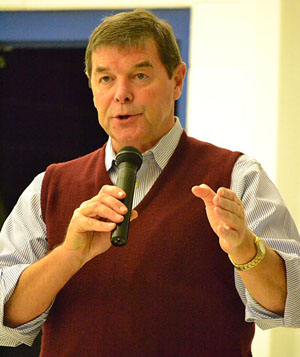Farmers get info on CAUV calculations
DAVE MOSIER/independent editor
Approximately 50 area farmers learned Monday evening that the same factors responsible for the current booming farm economy will likely lead to pocketbook woes when property tax bills come out in January.
The farmers, who met in the Lincolnview school cafeteria Monday evening, received a “good news-bad news” scenario from Larry Gearhardt of the Ohio Farm Bureau during his presentation on the factors that go into determining the 2011 Current Agricultural Use Valuation (CAUV) following property reappraisals completed this year.

Gearhardt went over the five factors used to determine CAUV — yield information, cropping pattern, average crop prices, non-land production costs and the capitalization rate — noting that two of those factors are mostly responsible for what will be an increase in property taxes this year for area farmers.
“Higher crop prices and lower interest rates mean higher CAUV rates,” he noted.
Ironically, those two factors have also put some welcome cash into farmers’ pockets during the three years since the last reappraisal update in 2008. The price for the good economic conditions, Gearhardt said, is the added dollop the state will likely take in property taxes for those in the CAUV program.
Unlike non-farming Ohioans, farmers’ property taxes aren’t figured on “fair market value”, but through the CAUV program first created in 1975. Like the Forest Tax Program for those involved in woodland management, the CAUV legislation was developed to give those whose land was used for agricultural purposes an estimated 50 percent reduction in their property taxes.
Gearhardt noted, though, that those with farmland have done much better than that for a number of years, with ag acreage owners seeing an estimated 90 percent reduction in value in 2005 and a 75 percent reduction last year over what they would have paid in taxes on their land’s fair market value.
He said that reduction would likely be somewhere between 65 and 60 percent for 2011, but added that figure is still well below the land’s fair market value.
Gearhardt provided those at the meeting with some insight into why crop prices and interest rates are raising havoc with CAUV values.
He explained that crop prices are determined using prices for just three crops: corn, soybeans and wheat. A fourth crop, hay, was included until 2010, Gearhardt noted, but was dropped because hay prices were hard to determine and skewed the results.
Crop prices are averaged over the most recent seven-year period, he explained, with the highest and lowest prices thrown out for a weighted five-year average. Prices for the most recent three years are added during a reappraisal or update, and the oldest three years used the last time are deleted, Gearhardt added, noting that factor further increased crop price averages this time around, since the three years deleted were significantly lower than the three years added.
The importance of the capitalization factor — interest rates — comes into play because it is used as a multiplier for the other factors in determining CAUV: a high interest multiplier lowers the CAUV land value, while a low interest multiplier increases it.
Gearhardt said that, while the current low interest rates are great when it’s time to borrow money to pay for production costs and other expenses, it has the opposite effect on CAUV.
“This low interest rate is killing us for CAUV,” said the Farm Bureau official, who is also a farmer.
Gearhardt did note that inflation also increased crop production costs, but not nearly enough to offset the rapidly rising crop prices.
The Farm Bureau official did get a laugh or two out of those at the meeting when he said it wouldn’t do any good to yell at Van Wert County Auditor Nancy Dixon, since the CAUV was determined by the Ohio Department of Taxation, not the county auditor.
Gearhardt also noted that any explanation of how the 2011 rate was determined would also have to come from the state, since rate calculations are also not provided to county auditors.
County Treasurer Bev Fuerst added her own bit of humor — one that earned some rueful laughs from those attending — when she said those who don’t want a property tax bill in January can instead get one earlier, in December.
Also at the meeting to provide information on the appraisal process was Richard Hoffman of Appraisal Research in Findlay.
POSTED: 11/22/11 at 3:31 am. FILED UNDER: News







